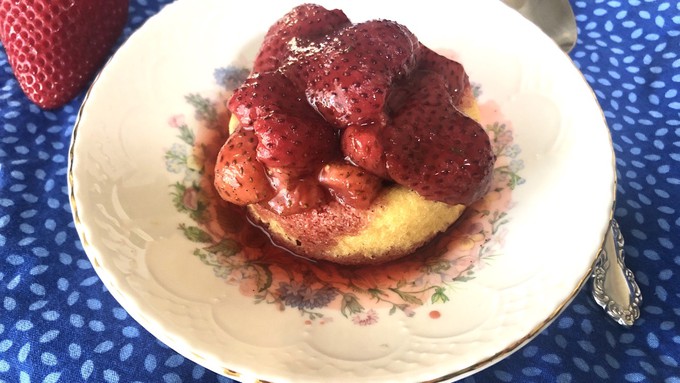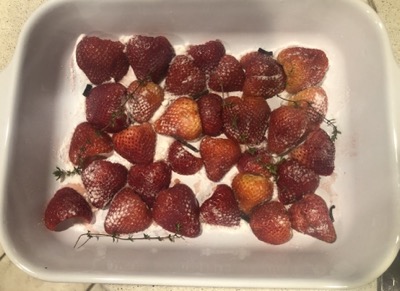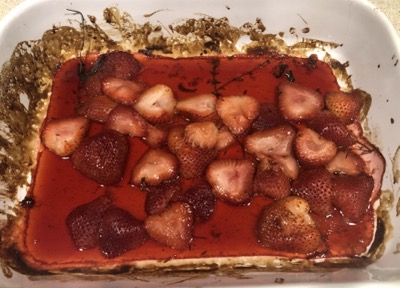
Recipe: Roasting the fruit concentrates flavors

Piled on a round of cake, roasted strawberries make an easy dessert. Add whipped cream or ice cream to dress them up even more. Kathy Morrison

Our local strawberries tend to reach their peak in May or June. Until then, I’m often lured to buy spring’s signature fruit – blushing red and glistening – even though I know the berries might not be the best for eating plain. (Standing over the sink to eat a juicy ripe berry is the ideal way, I believe.)
Several quick fixes exist for imperfect berries: A douse of balsamic vinegar is one, a whirr in the blender with some yogurt is another.
I’d heard of roasting strawberries but had never tried it until recently. It’s a good back-pocket kind of recipe because it’s endlessly adaptable yet requires only a few ingredients.
Roasting with a little bit of sweetener and some subtle flavoring concentrates the flavors of the fruit and yields, as a side benefit, a spectacular syrup. The strawberries and syrup can top ice cream or cheese cake, and they turn those ubiquitous dessert rounds from the grocery store into a fine dessert. (The cake soaks up the syrup beautifully.) For breakfast the berries also could be served as a compote, or top pancakes or French toast; they also would be an excellent addition to yogurt. Or try the syrup alone in a refreshing spring cocktail.
The recipe below is the basic procedure; feel free to play with it to your specific taste. It’s easily doubled.

Note: As I researched this method, there seemed to be no consensus on what temperature to roast the berries at. Some recipes said 350 degrees F, one was at 250 (for several hours!), and a few advised 400 degrees, which is closer to what I’d consider a roasting temperature. I settled on 375 degrees because I didn’t want the berries to dry out. But I might well try a higher temperature next time, to concentrate the sugars even more, though that would require more stirring so the berries don’t burn.
Roasted strawberries
Serves 2 as a fruit dish or 4 as part of a dessert
Ingredients:
1 pound fresh strawberries, washed and hulled
1 to 2 tablespoons sweetener, such as: granulated sugar, vanilla sugar*, brown sugar, maple syrup, honey, agave sweetener, rice syrup, or any other preferred sweetener
1 teaspoon vanilla extract, or a vanilla bean sliced and cut into chunks
Herbs (optional) such as 4 sprigs thyme, a handful of basil leaves sliced chiffonade, or some lemon verbena leaves
Optional stir-in after roasting: ½ tablespoon lemon or orange juice, or 1 teaspoon fruit liqueur, or 1 additional teaspoon vanilla extract
Instructions:

Heat oven to 375 degrees. Halve the hulled strawberries vertically and place them in one layer in a large non-reactive baking dish. (Quarter the larger ones if necessary.) Sprinkle the sweetener and the vanilla extract or bean pieces over the berries, then add the herbs (if using), and stir the whole thing together gently.
Roast 25-30 minutes, stirring the mixture at least once. Remove pan from the oven and allow berries to cool to almost room temperature. (They will get a bit jammier as they cool.) Taste the syrup and stir in any additional flavoring if desired. Use immediately or refrigerate in a covered container until ready to use.
* Make your own vanilla sugar by adding a vanilla bean -- even a used one -- to a small closed container of granulated sugar, such as a pint Mason jar. Shake and store.
Comments
0 comments have been posted.Sacramento Digs Gardening to your inbox.
Sites We Like
Garden Checklist for week of April 21
This week there’s plenty to keep gardeners busy. With no rain in the immediate forecast, remember to irrigate any new transplants.
* Weed, weed, weed! Get them before they flower and go to seed.
* April is the last chance to plant citrus trees such as dwarf orange, lemon and kumquat. These trees also look good in landscaping and provide fresh fruit in winter.
* Smell orange blossoms? Feed citrus trees with a low dose of balanced fertilizer (such as 10-10-10) during bloom to help set fruit. Keep an eye out for ants.
* Apply slow-release fertilizer to the lawn.
* Thoroughly clean debris from the bottom of outdoor ponds or fountains.
* Spring brings a flush of rapid growth, and that means your garden is really hungry. Feed shrubs and trees with a slow-release fertilizer. Or mulch with a 1-inch layer of compost.
* Azaleas and camellias looking a little yellow? If leaves are turning yellow between the veins, give them a boost with chelated iron.
* Trim dead flowers but not leaves from spring-flowering bulbs such as daffodils and tulips. Those leaves gather energy to create next year's flowers. Also, give the bulbs a fertilizer boost after bloom.
* Pinch chrysanthemums back to 12 inches for fall flowers. Cut old stems to the ground.
* Mulch around plants to conserve moisture and control weeds.
* From seed, plant beans, beets, cantaloupes, carrots, corn, cucumbers, melons, radishes and squash.
* Plant onion sets.
* In the flower garden, plant seeds for asters, cosmos, celosia, marigolds, salvia, sunflowers and zinnias.
* Transplant petunias, zinnias, geraniums and other summer bloomers.
* Plant perennials and dahlia tubers for summer bloom.
* Mid to late April is about the last chance to plant summer bulbs, such as gladiolus and tuberous begonias.
* Transplant lettuce seedlings. Choose varieties that mature quickly such as loose leaf.